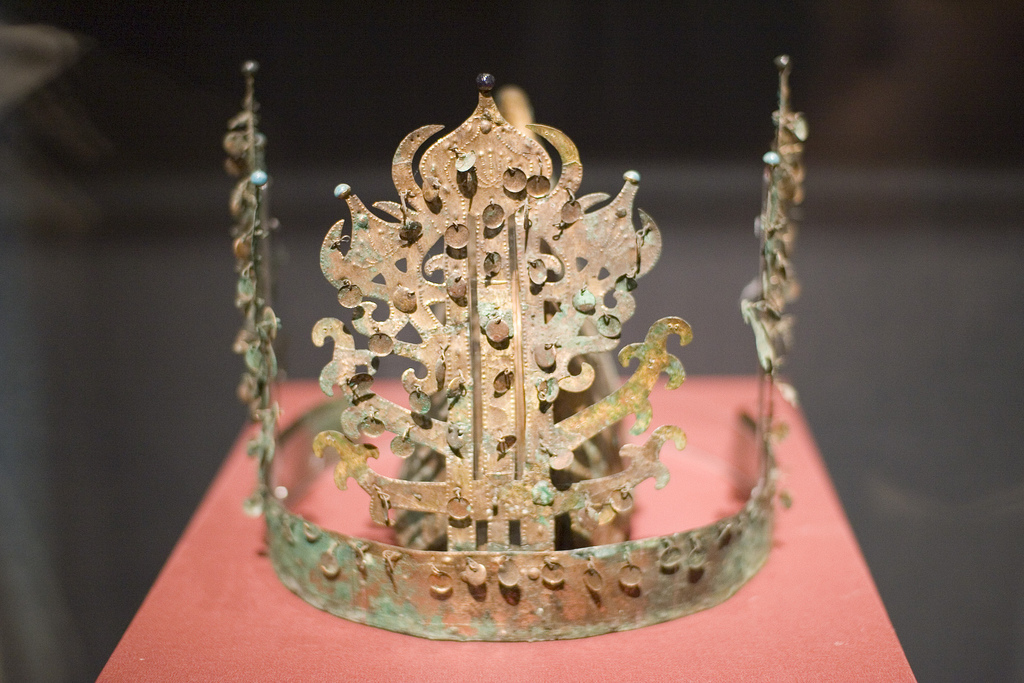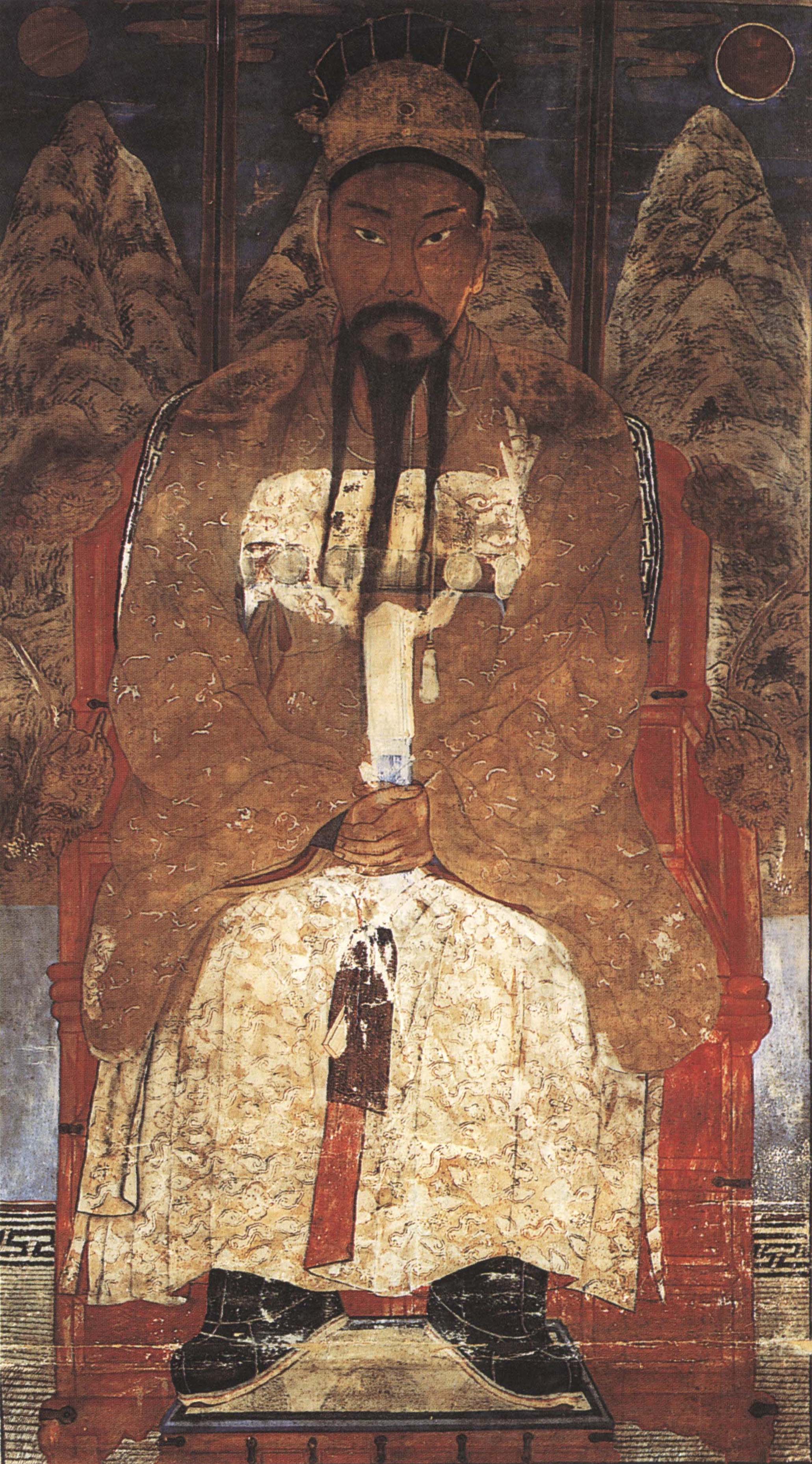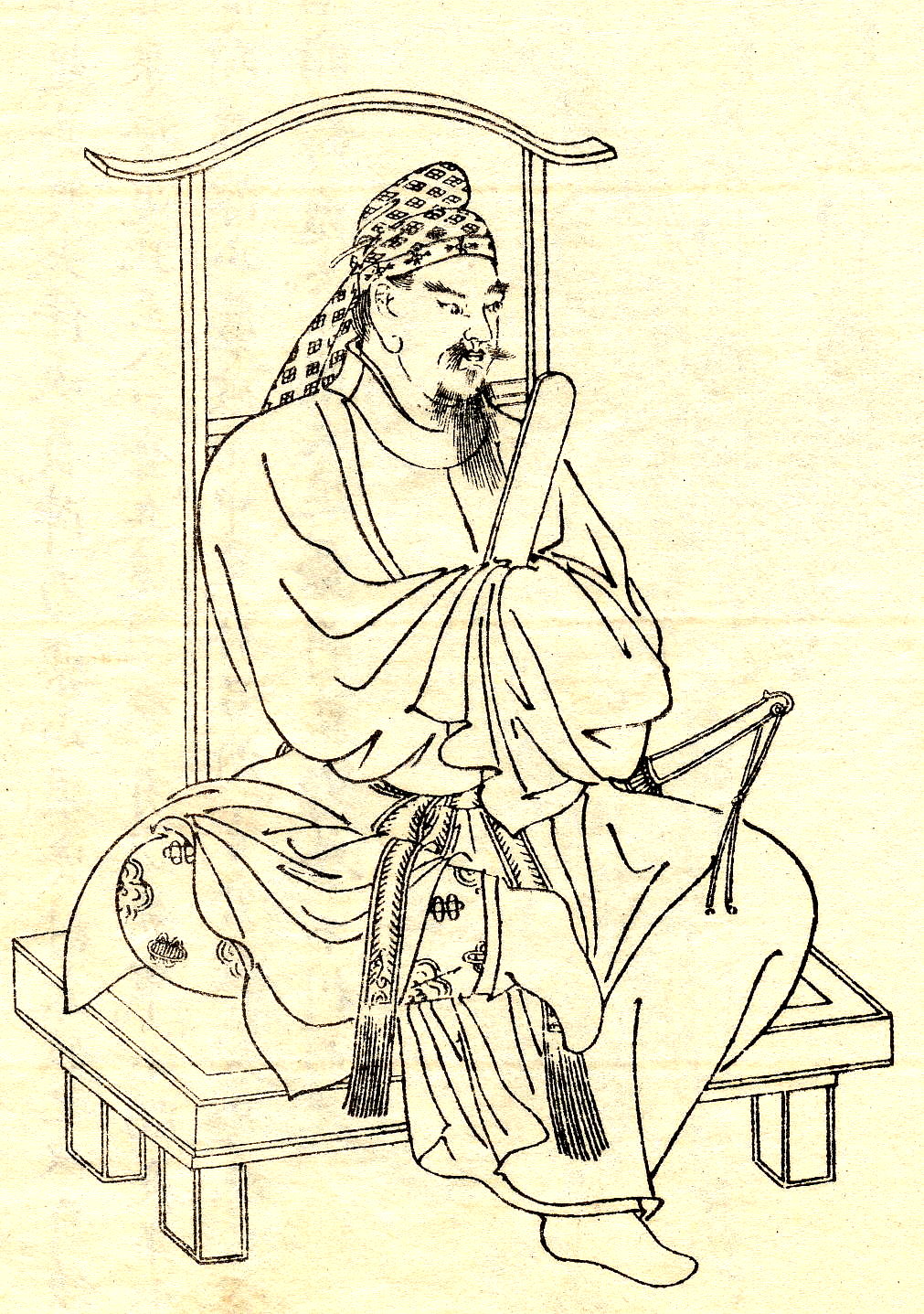|
Buyeo Pung
Buyeo Pung (扶餘豊, 623–668) was a prince of Baekje, one of the Three Kingdoms of Korea. He was son of the last king, Uija of Baekje. When Baekje fell to the Silla–Tang alliance in 660, he was a hostage who mortgaged the alliance of Baekje with Japan. He was shortly unofficially proclaimed king. He came back with a Japanese army and Yamato general Abe no Hirafu to revive the country. General Boksin of the Baekje revival forces gave him the title King Pungjang (). He joined forces with the Baekje resistance led by general Boksin. In 663, however, the Baekje resistance and Japan lost the Battle of Baekgang to the army of Tang and Silla, and Baekje collapsed. The prince fled to neighboring Goguryeo. When Goguryeo collapsed, he was captured by the Tang army and sent to southern China in exile. His later life is unknown. One of his brothers, Zenkō (善光 or 禅広), settled in Japan and was given the family name Kudara no Konikishi (百濟王; king of Baekje) by the empe ... [...More Info...] [...Related Items...] OR: [Wikipedia] [Google] [Baidu] |
Baekje
Baekje or Paekche (; ) was a Korean kingdom located in southwestern Korea from 18 BCE to 660 CE. It was one of the Three Kingdoms of Korea, together with Goguryeo and Silla. While the three kingdoms were in separate existence, Baekje had the highest population of approximately 3,800,000 people (760,000 households), which was much larger than that of Silla (850,000 people) and similar to that of Goguryeo (3,500,000 people). Baekje was founded by Onjo of Baekje, Onjo, the third son of Goguryeo's founder King Dongmyeong of Goguryeo, Jumong and Soseono, at Wiryeseong (present-day southern Seoul). Baekje, like Goguryeo, claimed to succeed Buyeo kingdom, Buyeo, a state established in present-day Manchuria around the time of Gojoseon's fall. Baekje alternately battled and allied with Goguryeo and Silla as the three kingdoms expanded control over the peninsula. At its peak in the 4th century, Baekje controlled most of the western Korean peninsula, as far north as Pyongyang, and may ha ... [...More Info...] [...Related Items...] OR: [Wikipedia] [Google] [Baidu] |
Jang Tae-sung
Jang Tae-sung (born September 27, 1980) is a South Korean actor. He has mostly played supporting roles. Filmography Film Television series References External links * * * 1980 births Living people 21st-century South Korean male actors South Korean male film actors South Korean male television actors Male actors from Busan Dongguk University alumni {{SouthKorea-actor-stub ... [...More Info...] [...Related Items...] OR: [Wikipedia] [Google] [Baidu] |
Korean Exiles
Korean may refer to: People and culture * Koreans, people from the Korean peninsula or of Korean descent * Korean culture * Korean language **Korean alphabet, known as Hangul or Korean **Korean dialects **See also: North–South differences in the Korean language Places * Korean Peninsula, a peninsula in East Asia **North Korea **South Korea Other uses *Korean Air, flag carrier and the largest airline of South Korea See also *Korean War, 1950-present war between North Korea and South Korea; ceasefire since 1953 *Names of Korea, various country names used in international contexts *History of Korea The Lower Paleolithic era on the Korean Peninsula and in Manchuria began roughly half a million years ago. Christopher J. Norton, "The Current State of Korean Paleoanthropology", (2000), ''Journal of Human Evolution'', 38: 803–825. The earl ..., the history of Korea up to 1945 * {{disambiguation Language and nationality disambiguation pages ... [...More Info...] [...Related Items...] OR: [Wikipedia] [Google] [Baidu] |
Baekje Monarchs
Baekje or Paekche (; ) was a Korean kingdom located in southwestern Korea from 18 BCE to 660 CE. It was one of the Three Kingdoms of Korea, together with Goguryeo and Silla. While the three kingdoms were in separate existence, Baekje had the highest population of approximately 3,800,000 people (760,000 households), which was much larger than that of Silla (850,000 people) and similar to that of Goguryeo (3,500,000 people). Baekje was founded by Onjo, the third son of Goguryeo's founder Jumong and Soseono, at Wiryeseong (present-day southern Seoul). Baekje, like Goguryeo, claimed to succeed Buyeo, a state established in present-day Manchuria around the time of Gojoseon's fall. Baekje alternately battled and allied with Goguryeo and Silla as the three kingdoms expanded control over the peninsula. At its peak in the 4th century, Baekje controlled most of the western Korean peninsula, as far north as Pyongyang, and may have even held territories in China, such as in Liaoxi, thou ... [...More Info...] [...Related Items...] OR: [Wikipedia] [Google] [Baidu] |
List Of Monarchs Of Korea
This is a list of monarchs of Korea, arranged by dynasty. Names are romanized according to the South Korean Revised Romanization of Korean. McCune–Reischauer romanizations may be found at the articles about the individual monarchs. Gojoseon Gojoseon (2333 BC – 108 BC) was the first Korean kingdom. According to legend, it was founded by Dangun in 2333 BC. Bronze Age archaeological evidence of Gojoseon culture is found in northern Korea and Liaoning. By the 9th to 4th century BC, various historical and archaeological evidence shows Gojoseon was a flourishing state and a self-declared kingdom. Both Dangun and Gija are believed to be mythological figures, but recent findings suggest and theorize that since Gojoseon was a kingdom with artifacts dating back to the 4th millennium BC, Dangun and Gija may have been royal or imperial titles used for the monarchs of Gojoseon, hence the use of Dangun for 1900 years. * : "An extreme manifestation of nationalism and the family cult was ... [...More Info...] [...Related Items...] OR: [Wikipedia] [Google] [Baidu] |
History Of Korea
The Lower Paleolithic era on the Korean Peninsula and in Manchuria began roughly half a million years ago. Christopher J. Norton, "The Current State of Korean Paleoanthropology", (2000), ''Journal of Human Evolution'', 38: 803–825. The earliest known Korean pottery dates to around 8000 BC and the Neolithic period began thereafter, followed by the Bronze Age by 2000 BC, Jong Chan Kim, Christopher J Bae, "Radiocarbon Dates Documenting The Neolithic-Bronze Age Transition in Korea" , (2010), ''Radiocarbon'', 52: 2, pp. 483–492. and the around 700 BC. The |
Buyeo Yung
Buyeo Yung (615–682) was the eldest son of King Uija, the last king of Baekje. He was appointed crown prince in 644, and would have been the kingdom's 32nd ruler. He is known as the progenitor of Buyeo Seo Clan (부여 서씨/扶餘徐氏) where he changed his surname to Seo. After his father was overthrown by an alliance of Silla and the Chinese Tang dynasty in 660, Buyeo Yung was sent into exile at the Tang capital Luoyang, along with his father. After the defeat of the Baekje restoration movement led by Boksin and Dochim at the Battle of Baekgang, which had sought to place Yung's brother Buyeo Pung on the throne, Tang felt the need for a ruler who could pacify the Baekje area. Beginning in 664, Buyeo Yung served briefly as the governor of the Ungjin Commandery () which Tang established to oversee the former territory of Baekje. After Silla expelled Tang forces from the Korean peninsula in 676, Buyeo Yung returned to Luoyang, where he spent the rest of his days. Popular ... [...More Info...] [...Related Items...] OR: [Wikipedia] [Google] [Baidu] |
Dream Of The Emperor
''Dream of the Emperor'' () is a South Korean television series that aired on KBS1 from September 8, 2012 to June 9, 2013 on Saturdays and Sundays at 21:40 for 70 episodes. Plot Kim Chun-chu is the grandson of King Jinji, but when his grandfather is overthrown, Chun-chu is denied the chance to become a successor to the throne of Silla. He later meets Kim Yu-shin, and the two men begin a friendship. Chun-chu later becomes King Muyeol, the 29th Silla monarch who leads the unification of three ancient Kingdoms – Goguryeo, Baekje and Silla, while Kim Yu-shin becomes one of the greatest generals in Korean history. Cast Main characters * Choi Soo-jong as Kim Chun-chu, later King Taejong Muyeol of Silla ** Chae Sang-woo as young Chun-chu *Kim Yu-seok as Kim Yu-shin **Noh Young-hak as young Yu-shin *Park Joo-mi (ep. 8 – 18) and Hong Eun-hee (episode 19 – 70) as Princess Deok-man, later Queen Seondeok of Silla **Seon Joo-ah as young Deok-man * Lee Young-ah as Queen Seungman ... [...More Info...] [...Related Items...] OR: [Wikipedia] [Google] [Baidu] |
KBS1
KBS 1TV is a South Korean free-to-air television channel that launched on 31 December 1961 and is owned by Korean Broadcasting System. The channel offers more serious programming than its sister channel KBS2, and airs with no commercials. History KBS1 was not the first television channel in South Korea. DBC (Daehan Broadcasting) was established on May 12, 1956 and aired to a limited television audience. The channel was owned by the Korean RCA Distribution Company (KORCAD) and initially took on its name, as well as the call sign HLKZ TV. The station broadcast on the same frequency KBS1 would later operate on in Seoul. An audience of hundreds of viewers watched the inaugural broadcast on 32 television sets installed in street corners, 25 in newspaper buildings and on school playgrounds throughout Seoul. It was the only television station in Korea before the start of AFKN TV on September 15, 1957. On February 2, 1959, a fire broke out at the DBC facilities, causing the station ... [...More Info...] [...Related Items...] OR: [Wikipedia] [Google] [Baidu] |
Fujiwara No Kamatari
, also known as , was a Japanese politician and aristocrat who, together with Prince Naka no Ōe (later Emperor Tenji), carried out the Taika Reform. He was the founder of the Fujiwara clan, the most powerful aristocratic family in Japan during the Nara and Heian periods. He, along with the Mononobe clan, was a supporter of Shinto and fought the introduction of Buddhism to Japan. The Soga clan, defenders of Buddhism in the Asuka period, defeated Kamatari and the Mononobe clan, and Buddhism became the dominant religion of the Imperial Court. Kamatari was appointed Inner Minister,Nussbaum, Louis-Frédéric. (2005). "Fujiwara no Tadahira" in ; Brinkley, Frank ''et al.'' (1915). and, along with Prince Naka no Ōe, later Emperor Tenji (626–672), launched the Taika Reform of 645, which centralized and strengthened the central government. Just before his death, he received the surname ''Fujiwara'' and the rank from Emperor Tenji, thus establishing the Fujiwara clan. Biography ... [...More Info...] [...Related Items...] OR: [Wikipedia] [Google] [Baidu] |
Three Kingdoms Of Korea
The Three Kingdoms of Korea or Samhan (Goguryeo, Baekje and Silla) competed for hegemony over the Korea, Korean Peninsula during the ancient period of History of Korea, Korean history. During the Three Kingdoms period (), many states and statelets consolidated until, after Buyeo was annexed in 494 and Gaya confederacy, Gaya was annexed in 562, only three remained on the Korean Peninsula: Goguryeo, Baekje and Silla. The "Korean Three Kingdoms" contributed to what would become Korea; and the Goguryeo, Baekje and Silla peoples became the Korean people. The three kingdoms occupied the entire peninsula and roughly half of Manchuria (modern-day Northeast China and small parts of the Russian Far East). Goguryeo controlled the northern half of the peninsula, as well as Liaodong Peninsula and Manchuria. Baekje and Silla occupied the southern half of the peninsula. The island kingdoms of Tamna and Usan were subordinated to Baekje and Silla, respectively. All three kingdoms shared a simila ... [...More Info...] [...Related Items...] OR: [Wikipedia] [Google] [Baidu] |
Kudara No Konikishi
The Kudara no Konikishi clan ( Japanese: 百済王氏, ''Kudara no konikishi-uji'') was a Japanese clan whose founder, Zenkō ( or ), was a son of King Uija, the last king of Baekje (located in the southwestern Korean Peninsula). Name ''Kudara'' was an ''uji'', or clan name, and represented its country of origin, Baekje. ''Konikishi'' or ''Kokishi'', which literally means "king", was a special ''kabane'' that was given only to the former royal families of Baekje and Goguryeo: the Kudara, Shōna (肖奈) and Koma (高麗) clans. History The founder Zenkō came from Baekje to Japan as a hostage along with his brother Hōshō in 643. Even though Japan sent Hōshō back to Korea for a failed campaign to revive Baekje, Zenkō remained in Japan. The former royal family members were treated as "barbarian guests" (蕃客) and were not incorporated into the domestic political system of Japan for some time. They enjoyed privileged treatment although they were obliged to serve to th ... [...More Info...] [...Related Items...] OR: [Wikipedia] [Google] [Baidu] |






